Mary Dudley Sutton (1586-1644) was a cousin of Lucy, Countess of Bedford and a friend of Lady Ann Clifford. She married Alexander, Earl of Home on 11 July 1605 at Bedford House on the Strand. Latin verse in 1617 celebrated her marriage and her ‘English hand’ rebuilding Dunglass Castle as an example for the Union of Scotland and England.
Widowed in 1619, she continued to build and extend family townhouses in Edinburgh and London, and collect paintings and bronzes. She was a patron of Francesco Fanelli, Nicolas Stone, Isaac de Caus, the Scottish mason William Wallace, and the decorator John Sawers. [1] Lady Home kept detailed inventories of her furnishings over twenty years, noting paintings and bronzes, and the contents of her cabinets. Reception rooms furnished with marble tables and ‘chairis of the Italliane fassione’ in Aldersgate and Edinburgh’s Canongate followed court tastes.
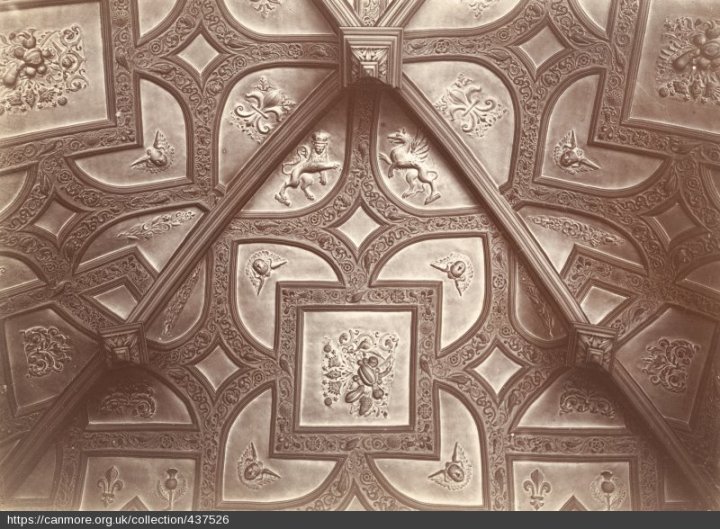
Ceiling at Moray House, probably by John White for Lady Home, c.1633. (HES)
The artistic decoration of the cabinet was subordinate to rarefied forms of domestic production and study. Lady Home served sweetmeats and kept glassware and stills for physic. These sustaining activities were reflected in the themes of pictures including the Roman Charity, Tobias and the Angel, Abigail, Esther, and Cleopatra. She bought loadstones, burning glasses, a weatherglass, telescopes including a prospect glass of gilt leather with ivory lens caps, and a silver horological ring dial. These objects represent a recreational interest in natural philosophy shared and enjoyed by women in her circle, to whom she gifted some of this luxurious apparatus. She and her daughters (and daughters-in-law) copied and shared recipe books
Home identified herself as member of the Harington family, using beds, cushions, an embroidered tablecloth, and even Delft tiles decorated with the Harington knot, which she bought from sales of the furnishings of her cousin Lucy, Countess of Bedford’s London houses. After Bedford’s death, a group of Harington women including Home and her mother were identified in the will of William Mason of Westminster, extending to Lady Carr Cromwell and Catherine Dyer of Staughton and Colmworth, who wrote ‘My Dearest Dust’ as an epitaph for her husband.
Furnishings at Moray House
At Moray House in Edinburgh, rooms functioned in clusters with access provided by at least three turnpike stairs. From the inventory made in the 1630s, the street balcony room, on the upper floor, was furnished in black and gilt with a funereal black day couch, next was the great dining room, and beyond a more cheerful drawing chamber, which had a day couch in green velvet with silver lace; a painting of a Washing Wench and a night scene over the fireplace. Beyond this was the gallery room, with forty paintings, a marble table, Italianate chairs, billiards and backgammon.
Next was another drawing room, with a chequered floor, with its own stair to the courtyard, the antechamber to Lady Home’s bedchamber suite and cabinet. Rooms for her two daughters and a nursery led off the garden balcony room, next to the street balcony room, furnished with dummy board portaits of her grandchildren and their dwarf servant Meg Candy. Female servants slept above in the garret. On the floor below there were rooms for the young earl of Home, and the male servants under Adam Young and the butler James Simpson.
On the ground floor there were ‘vault’ rooms, also with couches, Italian chairs, paintings and marble tables. This suite of rooms may have opened into the garden, described in this article. In its planning this building owed nothing to the traditional layout of Edinburgh townhouses, with front hall and inner chambers, or indeed to previous Scottish architecture, but was intended to realise some of functions of a London townhouse, with a disproportionate number of reception rooms.
The furnishings were bought in London and echoed court furniture and taste. The new balcony room was probably finished in 1633 and it was expected that Charles I would use the house during his coronation visit. There was a portrait of Henrietta Maria and the court dwarf Jeffrey Hudson in this room, a relatively inexpensive copy of a work by Van Dyck or Daniel Mytens, bought for £5.
As dowager Countess, Lady Home enjoyed an impressive income from the Home lands in Berwickshire, building and decorating houses in England and Scotland, and looking for eligible English brides for her son, and Scottish husbands for her daughters. Her daughter-in-law Grace Fane copied a rental of the Barony of Home into a vellum notebook fastened with pink taffeta ribbons.
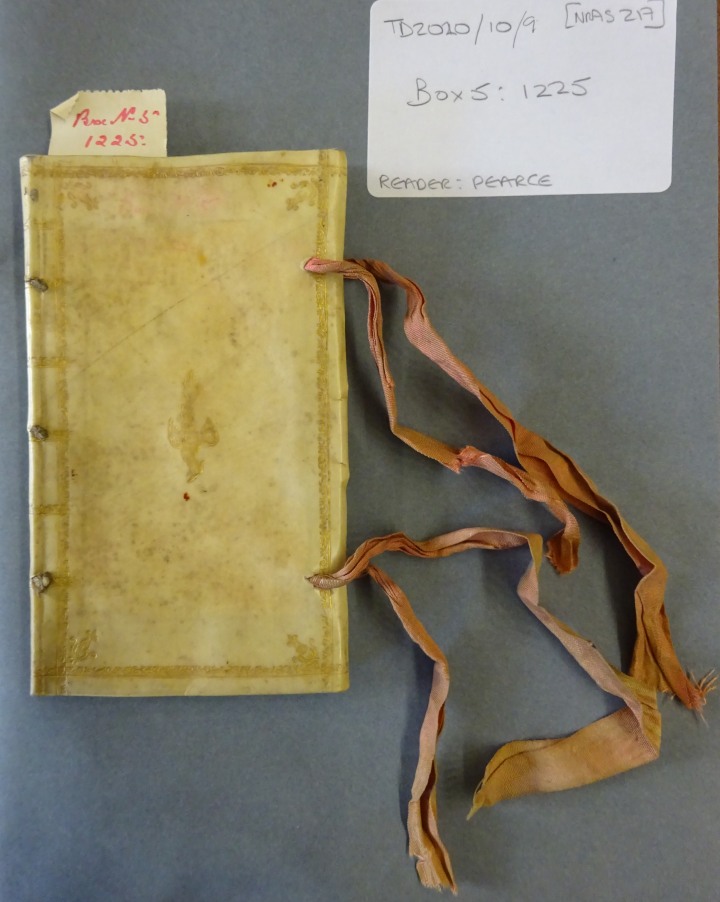
Lady Home kept inventories of all her houses, which she called ‘counts’. Most of the text was written by her Scottish servants, but she added notes herself, as did her housekeepers. She also gave her accounts similar scrutiny, inspecting the arithmetic and adding critical notes. The text of the major inventories can be found on my academia page.
The detail in these inventories is overwhelming. Eventually she found her system unwieldy, unable to reconcile the Turkish or turkey work carpets recorded by her housekeeper Mary Reid with her own ‘book of many sundry particular things’. This kind of household record must be rare.

A note by Mary Countess of Home, 10 August 1642, (NRAS 217 box 5 no. 12) [2]
Dividing a collection between two daughters
When Lady Home died in 1644 her furnishings were to be divided between her daughters, Margaret, Lady Moray, and Anne, Lady Lauderdale. The inventories show that some of her cabinet things were in London, and some in Edinburgh, and surviving papers detail the division of the cabinet furnishings between the sisters, and the difficulties encountered. First, in the inventories items in London were marked with a cross. This didn’t work out, so other lists were made to try to reconcile items and sisters; one has a heading that reveals the problem;
‘A note of the closset in the Canongait. Ane not of such thingis as is set doune in the cabinat of the Canongait that is not set down in the cabinet in Aldersgate streit’
In another paper, Margaret Home, Lady Moray described what her husband Lord Moray should claim for her in London; her recollection of things that properly belonged in the Edinburgh cabinet, noting:
‘thair is many littill small things that stand in the closset that is not nameit all which is to be devydit’
The difficulty was caused by Lady Home travelling with many of her cabinet things, rendering the inventories irrelevant. Finally, in May 1645 Margaret, Lady Moray’s share of furniture in Aldersgate and Highgate furniture was shipped to Scotland. Many of these items can be identified in additions to the inventory made by the housekeeper Dorothy Spense.[3] At the same time furnishings were consigned to Lauderdale, including a group of items originally at Dunglass Castle, as per their contract;
Earl of Murray’s bond for Dunglasse Stuff
We James Earl of Murray and Margaret Countess of Murray faithfully bind and obliges us to deliver to John Earl of Lauderdale, … all that belonged to Dunglasse that is now in the Canongate, … excepting such as by the books appear to have been since appointed for the houses in the Canongate Floores or Twitnam, 21 May 1645 London.[4]
Lauderdale was declared a delinquent in 1650 and the Aldersgate house and Highgate House were sequestered, and occupied by John Ireton. At the restoration Lauderdale was entitled to recover furnishings from John Ireton and other assignees, and some of Lady Home’s possessions may eventually have found its way to Thirlestane Castle and Ham House. It is unclear if much was recovered. Lauderdale certainly embellished Ham House and its gardens from his mother-in-law’s houses. In 1671 Lauderdale’s son-in-law Lord Yester wrote from Highgate that he had ‘quite spoyld the gardens there by taking all the best fruit trees and carrying them to Hame’. [5]
A wider historical question is the impact of Lady Home’s decor in Scotland. It reflects court culture and new fashions, the taste of the Whitehall group, in a way that is hard to detect in other Scottish inventories of the 1630s. The great collection formed by the Marquesses of Hamilton was kept in London, and picture galleries in Scotland are represented only by treasurer Morton’s gallery at Aberdour Castle, which had 49 paintings and a marble table by 1647.
The Earl of Morton was obviously impressed with Lady Moray’s Canongate house and in 1633 he wrote to her requesting the house for Charles I to use during his Scottish coronation. Although Lady Home did not have had the deep purse of the Whitehall collectors or their network of international contacts, she was the first to bring a comprehensive London style to Edinburgh, which the uninitiated must have found somewhat puzzling, with a bronze St George by Francesco Fanelli displayed at the Canongate and a Winged Mercury poised on a turtle probably by Hubert le Sueur in the garden of her daughter’s house at Donibristle.
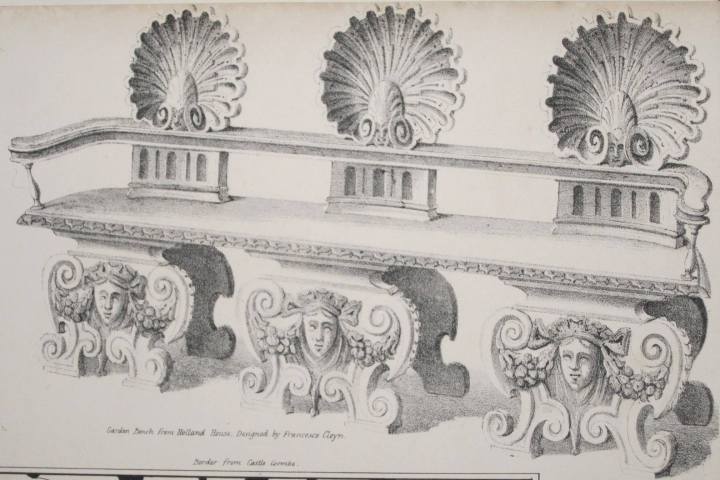 A gilded couch of ‘carved work like scallop shells’ cost Lady Home £4-16s in 1644, C.J. Richardson, Studies from Old English Mansions, vol. 2 (London, 1842)
A gilded couch of ‘carved work like scallop shells’ cost Lady Home £4-16s in 1644, C.J. Richardson, Studies from Old English Mansions, vol. 2 (London, 1842)
There were forty eight silver hooks to hang paintings in the cabinet, and there are over a hundred paintings mentioned in Lady Home’s inventories, many by subject. Prices given in the inventories suggest these were relatively inexpensive small cabinet pictures, copies which cost around 30 shillings on copper, some of which were bought at the Royal Exchange. Two paintings came from George Geldorp and were perhaps copies of portraits. [6]
Science, medicine, and recreation in the closet
The contents of the closet also invite reconsideration of the meanings of recreation, because it is clear from these inventories that Lady Home used her closets for activities that were recreative in both the spiritual and physical sense. While the closet is associated with women’s recipes for physic, cordials, preserves and sweetmeats, we are usually thinking of the activity of writing and compiling that produced closet secrets, Lady Home seems to have performed the activities of making in closets in her galleries and her bedroom closets. Glass stills, alembics and funnels, and pestles and mortars are listed in these spaces, with vessels and vials of glass, crystal and agate. She had no still rooms, and the equipment listed in the kitchen is unexceptional.
The inventories give little clue to the exact nature of her activities with this specialised equipment, apart from making rose water and cinnamon water, which could be quite a potent alcoholic remedy. A letter, perhaps from 1633 outlines a recipe and mentions the copying of recipe books. Three recipe books compiled for her daughter survive in the family archives, with many medical recipes and conserves, many of the latter attributed to a Mistress Young. Lady Home constructed large gardens in Edinburgh and at Floors, which must have provided some of the ingredients for her work and kitchen produce. Her books included Gervase Markham’s Country Farm, John Parkinson’s Paradisi, or A garden of all sorts of pleasant flowers, and the General practise of physicke conteyning all inward and outward parts of the body, Compiled by Christopher Wirtzung.
Physic in the closet extended into choices of decoration by the subjects of paintings. Paintings hanging in the closet included the Roman Charity, and Tobias and the Angel, Abigail and David, and Martha and Mary, themes which mirror the production of and ingestion of sustenance, food and remedies. Alethia, Countess of Arundel, had a Tobias and the Angel in her Pranketing room, perhaps a copy after Adam Elsheimer, there is a version of this painting at Ham. [7] The subject is particularly resonant, a fish which provided food, and was an olfactory remedy against demons, and an ointment for cataracts.
An interest in health can be seen in letters from Mary Fane, Countess of Westmorland, Grace Mildmay’s daughter, to Grace Fane, Countess of Home. Grace had had smallpox, and a miscarriage or phantom pregnancy leaving her swollen and was clearly unwell. In 1626 her mother Mary Fane sent a recipe for face-cream to heal the scars. Westmorland was optimistic that Grace would recover her health and become pregnant, even as William Waller’s first wife, Jane Reynell had after seven years, who was a ‘litle crooked woman, the head and shoulders lower than myself, the most deformed that ever I saw’. Her own grandmother, Lady Despencer had waited years to become pregnant. She was sceptical about advice received from Lady Home’s Dr Arnot in Edinburgh, and sought an opinion from Dr Leonard Poe and from the London College of Physicians, sending to Grace her comments on Poe’s recommendations and the fruits of her researches, saying Dr Arnot should;
‘judge of them, it may be the better for many good women in Scotlande; for they be not my conceits, nor one or two phisitions, nor only practiced by me, but they have been directed by divers learned men, & practiced with good successe upon diverse’[8]
Grace left a treatment diary describing Dr Arnot’s prescriptions, which her sister-in-law later copied in a recipe book. Margaret, Lady Doune, later Countess of Moray, was clearly very fond of Grace, and as well as memorialising her in the recipe book, kept her letters from her mother the Countess of Westmorland, her vellum notebook of the Barony of Home, and a small selection of her papers for 50 years after her death in 1633. The family papers were arranged in chronological order in the nineteenth century.
Lady Home’s and her daughter’s closets also contained a surprising number of scientific objects or artificial instruments, including a telescope, described as ‘a gilt leather prospect glass with ivory heads to cover the glasses’ which cost £15 in London in 1634, and burning glasses, one of which cost 15s., multiplying glasses, a weather-glass, loadstones, a crystal ball, and a silver horological ring dial.
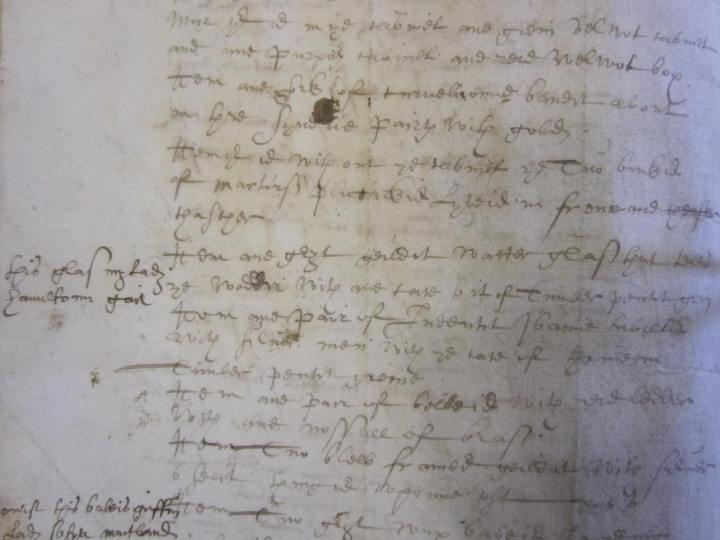
A weatherglass in the cabinet at Moray House, (NRAS 217 box 5 no. 5)
The weather-glass was a kind of simple barometer, with a water level that changed according to air pressure and temperature, illustrated on the title page of John Bates’ Mysteries of Art and Nature. This weather glass was a particularly fine object, in a gilt and painted box, and was given to a Lady Hamilton, presumably Anne Cunningham, Marchioness of Hamilton, evidence of of shared interest in some branches of natural philosophy. Without any clues from correspondence it is a challenge to identify or imagine the activity that Lady Home’s collection represents, closely resembling items in the middle section of the shop boy’s cry in Ben Jonson’s 1609 Entertainment for Britain’s Burse;
‘What do you lack? What is’t you buy?, … sundials, hourglasses, looking-glasses, burning-glasses, concave glasses, triangular glasses, convex glasses, crystal globes, waxen pictures, ostrich eggs …’ [9]
Lady Home had no instruments for measurement or drawing, no geometric instruments or navigational tools, except the ring dial. These objects may represent a particular field of natural philosophy, of practical demonstration of visual effects, which was performed as a social activity. Possibly the closet objects were used as described in the Mathematicall Recreations (1633) or John Bates’ Mysteries of Art and Nature as recreational activities practised by an elite. The author of the Mathematicall Recreations, make this very clear, both in the small print of the title page, and in a preface. His book was
‘fit for scholars, students and gentlemen that desire to know the philosophical cause’ [… ] useful for others, to acuate and stir them up to the search for further knowledge and serviceable to all for many excellent things both for pleasure and recreation’
It is tempting to identify the ‘others’ to include Lady Home’s circle and other New Exchange customers, wealthy women in general, as people who might be stirred up to search for further knowledge, but would certainly find pleasure and recreation with finely crafted luxury novelties. The theme is amplified in the preface of the Recreations;
‘to give a greater grace to the practise of these things, they ought to be concealed as much as they may, … for that which doth ravish the spirits is, an admirable effect, whose cause is unknown: which if it were discovered, halfe the pleasure is lost, therefore all the finesse, consists in the dexterity of the Act, concealing the means.’
A performance is intended. Some historians have assumed this was an unrealised ideal of recreation, or deprecated the Recreations as a primer for parlour tricks. It has also been suggested as an aid to conversions by providing confrontations with wonder and the inexplicable mystery of the divine. While this origin is possible, the content of the Mathematicall Recreations may also simply reflect a leisure activity already popular amongst elites, and particularly amongst elite women.
These luxury items, which Lady Home almost certainly bought at the New Exchange, would have complimented her other more practical activity, the production of physic. They served a rhetorical and social purpose, expressing to her guests her expertise and mastery of the physical world. Expensive luxury apparatus for magic tricks or scientific demonstrations in the closet underwrote the medical expertise she practised in her cabinet, and expensive apparatus demonstrated that the knowledge was reserved to an elite, and distanced from folk-knowledge.
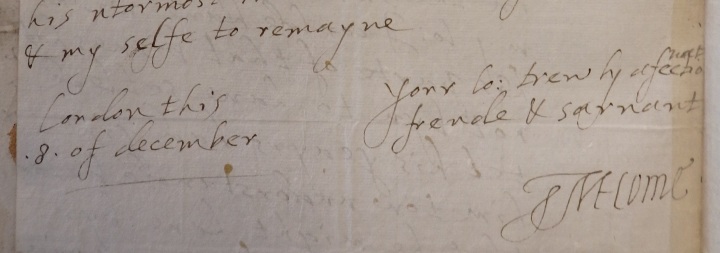
Signature of Lady Home, 8 December 1624, NLS Adv. 31.1.1 vol. 10 no. 95.
[1] K. Acheson, Ann Clifford: The Memoir of 1603 and the Diary of 1616-1619 (Broadview, Toronto, 2007), 91-3, 165, 167: W. G Spiers, ‘Account Book of Nicolas Stone’, 7th Volume of the Walpole Society (Oxford, 1919), 117, Lady Home employed Isaac de Caus to order a black and white marble chimney piece from Nicolas Stone for her house in Aldersgate in August 1637. Around this time, as she recorded in her will, she visited Stone in Longacre to discuss plans for a tomb to be erected in the church at Dunglass. Spiers’ biographical note is confused.
[2] The inventories made by Mary Lady Home are held privately, and are accessible through the National Register of Archives for Scotland scheme (NRAS 217 box 5).
My transcripts of the major inventories are available here, from academia
[3] A intercepted letter from Dorothy Spense was printed in Letters from the Marquess of Argyle … & friends at Edinburgh, (Oxford 1645), p. 8.
[4] National Library of Scotland, MS.14547, Executry of Lady Home.
[5] NLS MS. 14547, f.134, letter of John Hay 1671: Cf. G. Mandelbrote, ‘The Library of the Duke of Lauderdale (1616-1682)’ in C. Rowell, Ham House 400 Years of Collecting and Patronage (London, 2013), p. 222, quoting Ann Home’s letter to Lauderdale, BL Add. MS. 23,134 f.123, 22 September 1670.
[6] For a discussion of copies in the seventeenth-century British art market, see Susan Bracken, ‘Copies after Old Masters at Ham in the Context of Caroline Patronage and Collecting’ in Rowell, Ham House, 37-48.
[7] J. Claxton, ‘The Countess of Arundel’s Dutch Pranketing Room’, Journal of the History of Collections 22 (2) (2010), pp. 187-196.
[8] NRAS 217 box 5 no. 295 , Mary Countess of Westmorland to Grace Fane, Countess of Home, 31 March 1627. see transcripts of these letters here
[9] J. Knowles, ‘Jonson’s Entertainment at Britain’s Burse’ in M. Butler, Re-presenting Ben Jonson: Text, History, Performance (New York, 1999).
This post is based on talks given at the 4th New Insights into 16th-and 17th-Century British Architecture conference, 24 January 2015 organised by Claire Gapper & Paula Henderson and at Mobile and Temporary Domesticities, 1600-2017, 10 October 2017 organised by Tessa Chynoweth and Laika Nevalainen.
One thought on “Closet and Cabinet”